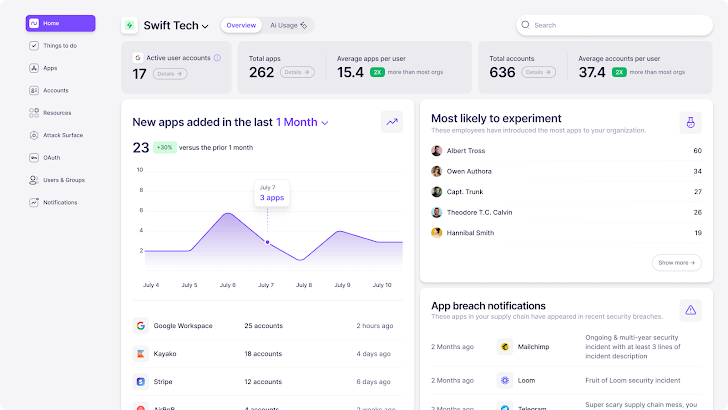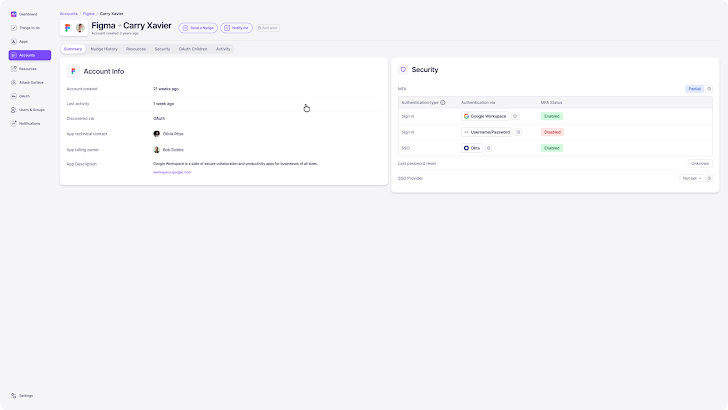As technology adoption has shifted to be employee-led, just in time, and from any location or device, IT and security teams have found themselves contending with an ever-sprawling SaaS attack surface, much of which is often unknown or unmanaged. This greatly increases the risk of identity-based threats, and according to a recent report from CrowdStrike, 80% of breaches today use compromised identities, including cloud and SaaS credentials.
Given this reality, IT security leaders need practical and effective SaaS security solutions designed to discover and manage their expanding SaaS footprint. Here are 5 key ways Nudge Security can help.
Close the visibility gap
Knowing the full scope of SaaS apps in use is the foundation of a modern IT governance program. Without an understanding of your entire SaaS footprint, you cannot say with confidence where your corporate IP is stored (Did someone sync their desktop to Dropbox?), you cannot make assumptions about your customer data (Did someone upload your customer list to a new marketing app?), and you certainly can’t make strong assertions about your production data (Did someone clone their environment into a new AWS account to recreate a support issue?).
But, given the pace of SaaS adoption, it is a never-ending, pain-staking task to collect and maintain an accurate SaaS inventory. Nudge Security addresses this problem with real-time, continuous SaaS discovery that does not require agents, browser plug-ins, network proxies, or complicated API configurations. Within minutes of starting a free trial, you will have a full inventory of all SaaS accounts ever created by anyone in your org, along with security context on each app, alerts as new apps are introduced, and the ability to automate SaaS governance tasks.

Manage OAuth risks
Today, any employee has the power at their fingertips to string together multiple SaaS applications and data using no-code / low-code integrations that leverage authorization methods like OAuth grants. This creates a complex mesh of SaaS applications, making it extremely difficult to answer the fundamental question of, “who (and what SaaS applications) have access to my corporate assets?” Attackers are taking advantage of this complexity to move laterally across the SaaS supply chain to get to the crown jewels.
Given this, it’s important for IT and security teams to regularly review the OAuth grants that have been introduced for their organization to identify and address overly permissive scopes and app-to-app connections that may run contrary to data privacy and compliance requirements.
This article provides an overview of key steps for analyzing OAuth grants and assessing potential risks, along with an overview of how Nudge Security provides the context you need to simplify this process.

Monitor your SaaS attack surface
Recent high-profile SaaS supply chain breaches at Circle CI, Okta, and Slack reflect a growing trend in attackers targeting enterprise SaaS tools to infiltrate their customers’ environments. As mentioned above, the complex and interconnected nature of the modern SaaS attack surface makes it possible for attackers to move through the software supply chain to find valuable assets.
Given this reality, it’s important to understand what corporate assets are visible to attackers externally and, therefore, could be a target. Arguably, the SaaS attack surface extends to every SaaS, IaaS and PaaS application, account, user credential, OAuth grant, API, and SaaS supplier used in your organization—managed or unmanaged. Monitoring this attack surface can feel like a Sisyphean task, given that any user with a credit card, or even just a corporate email address, has the power to expand the organization’s attack surface in just a few clicks.
Nudge Security includes a SaaS attack surface dashboard to show you all externally facing assets attackers could see, including SaaS apps, cloud infrastructure, dev tools, social media accounts, registered domains, and more. With this visibility, you can take proactive steps to minimize and protect your SaaS attack surface.

Expand SSO coverage
Single sign-on (SSO) provides a centralized place to manage employees’ access to enterprise SaaS applications, which makes it an integral part of any modern SaaS identity and access governance program. Most organizations strive to ensure that all business-critical applications (i.e., those that handle customer data, financial data, source code, etc.) are enrolled in SSO. However, when new SaaS applications are introduced outside of IT governance processes, this makes it difficult to truly assess SSO coverage.
Nudge Security shows you which apps are enrolled in SSO (and which are not) along with context on each app so you can appropriately prioritize your SSO onboarding efforts. When you are ready to onboard new apps to your SSO tool, Nudge Security initiates SSO onboarding workflows to make the process easier.

Extend MFA usage
Multi-factor authentication adds an extra layer of security to protect user accounts from unauthorized access. By requiring multiple factors for verification, such as a password and a unique code sent to a mobile device, it significantly decreases the chances of hackers gaining access to sensitive information. This is especially important in today’s digital landscape where identity-based attacks are increasingly common.
With Nudge Security, you can see which user accounts do (and don’t) have MFA enabled, and send “nudges” to users via email or Slack to prompt them to enable MFA for their accounts. With the long-tail of applications often adopted without IT oversight, this visibility helps IT teams ensure that SaaS security best practices are followed.

Start improving SaaS security today
Nudge Security gives IT and security teams complete visibility of every SaaS and cloud asset ever created in their orgs (managed or unmanaged), and real-time alerts as new accounts are created. With this visibility, they can eliminate shadow IT, secure rogue accounts, minimize the SaaS attack surface, and automate tedious tasks, all without impeding the pace of work.
Start a free 14-day trial here.
